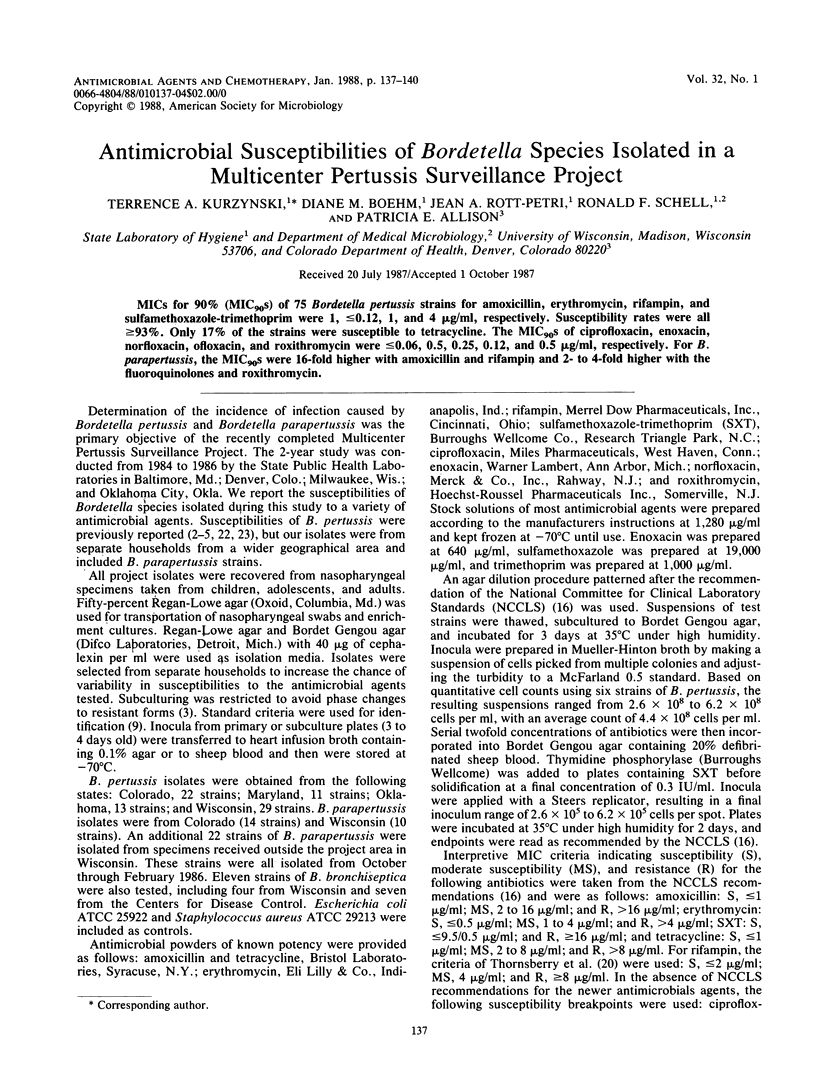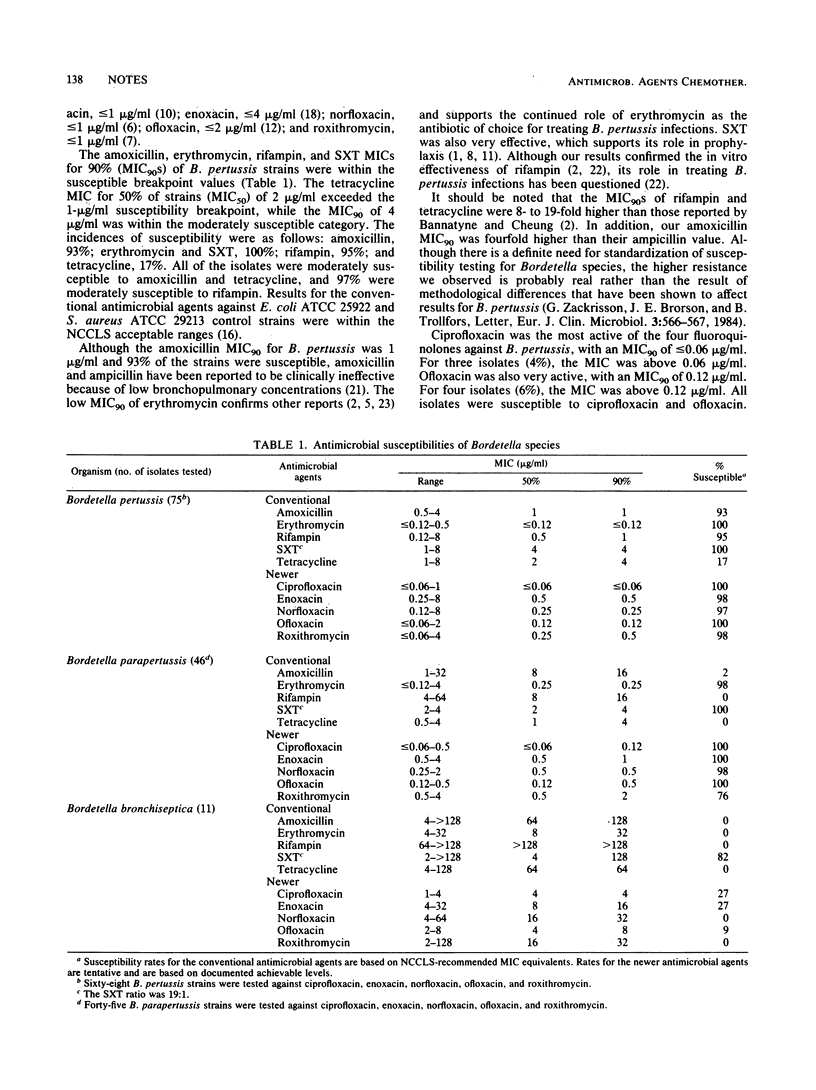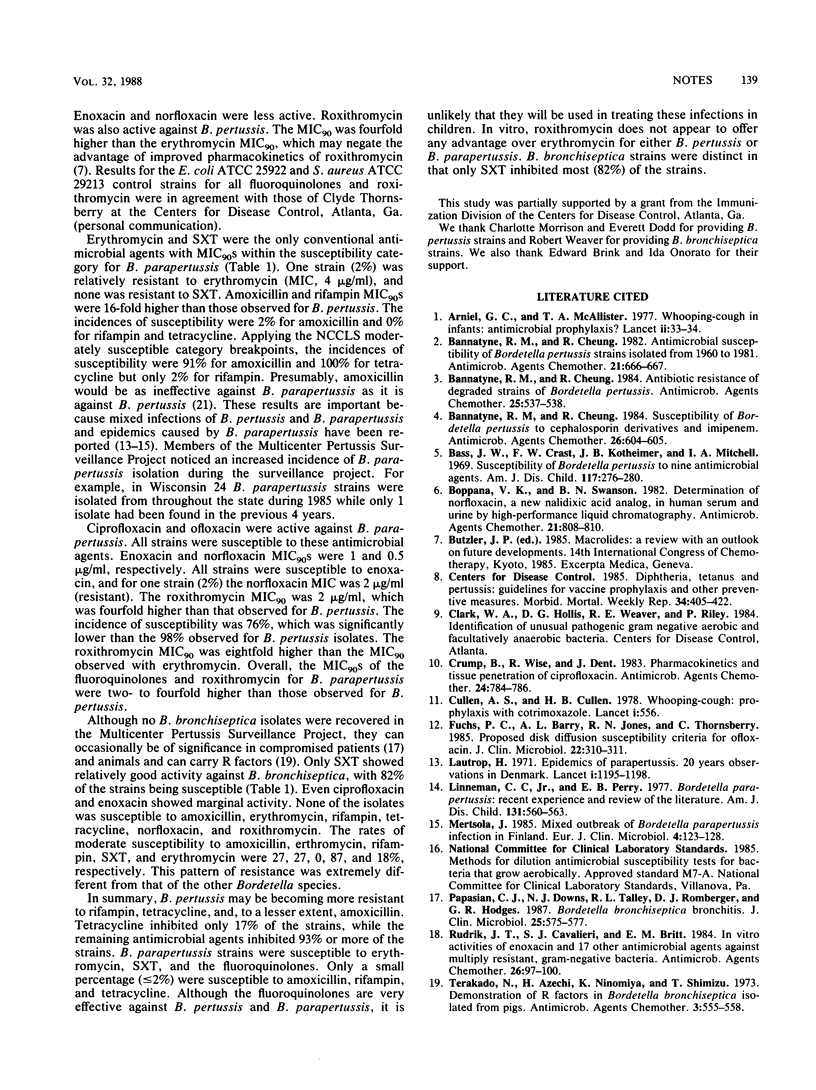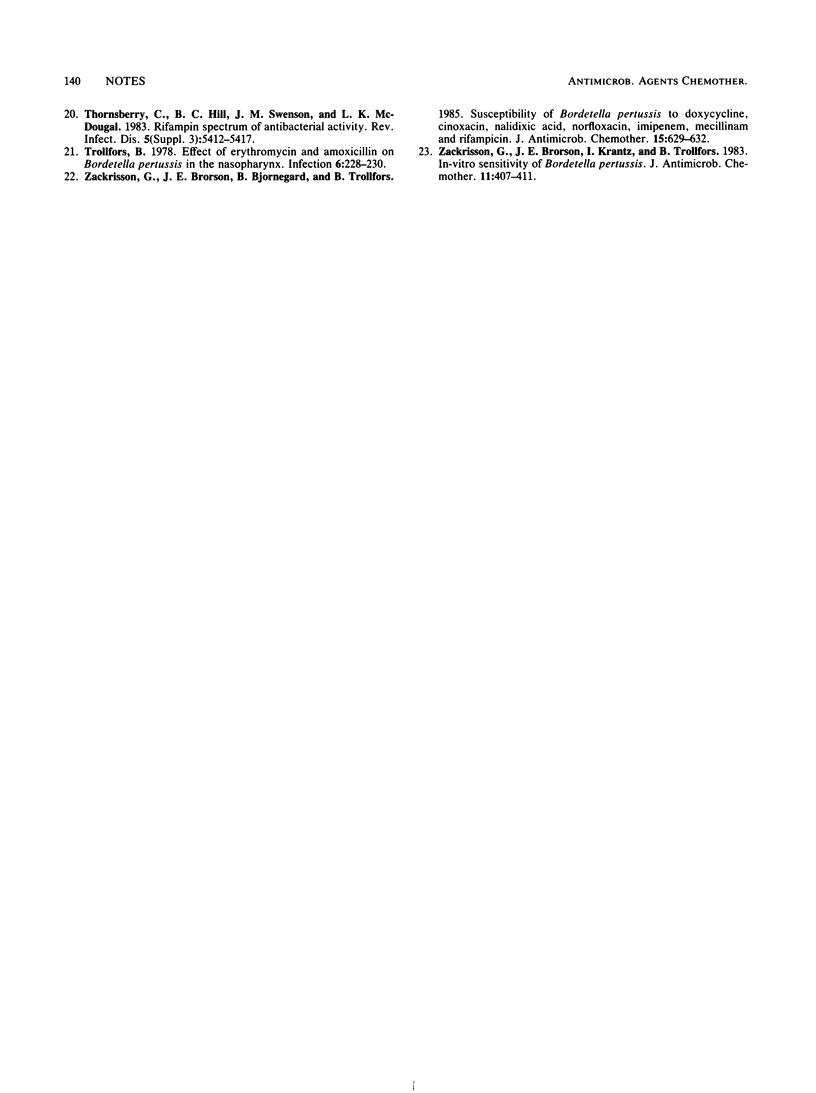Abstract
MICs for 90% (MIC90s) of 75 Bordetella pertussis strains for amoxicillin, erythromycin, rifampin, and sulfamethoxazole-trimethoprim were 1, less than or equal to 0.12, 1, and 4 micrograms/ml, respectively. Susceptibility rates were all greater than or equal to 93%. Only 17% of the strains were susceptible to tetracycline. The MIC90s of ciprofloxacin, enoxacin, norfloxacin, ofloxacin, and roxithromycin were less than or equal to 0.06, 0.5, 0.25, 0.12, and 0.5 micrograms/ml, respectively. For B. parapertussis, the MIC90s were 16-fold higher with amoxicillin and rifampin and 2- to 4-fold higher with the fluoroquinolones and roxithromycin.
Full text
PDF



Selected References
These references are in PubMed. This may not be the complete list of references from this article.
- Arneil G. C., McAllister T. A. Whooping-cough in infants: Antimicrobial prophylaxis? Lancet. 1977 Jul 2;2(8027):33–34. doi: 10.1016/s0140-6736(77)90021-6. [DOI] [PubMed] [Google Scholar]
- Bannatyne R. M., Cheung R. Antibiotic resistance of degraded strains of Bordetella pertussis. Antimicrob Agents Chemother. 1984 Apr;25(4):537–538. doi: 10.1128/aac.25.4.537. [DOI] [PMC free article] [PubMed] [Google Scholar]
- Bannatyne R. M., Cheung R. Antimicrobial susceptibility of Bordetella pertussis strains isolated from 1960 to 1981. Antimicrob Agents Chemother. 1982 Apr;21(4):666–667. doi: 10.1128/aac.21.4.666. [DOI] [PMC free article] [PubMed] [Google Scholar]
- Bannatyne R. M., Cheung R. Susceptibility of Bordetella pertussis to cephalosporin derivatives and imipenem. Antimicrob Agents Chemother. 1984 Oct;26(4):604–605. doi: 10.1128/aac.26.4.604. [DOI] [PMC free article] [PubMed] [Google Scholar]
- Bass J. W., Crast F. W., Kotheimer J. B., Mitchell I. A. Susceptibility of Bordetella pertussis to nine antimicrobial agents. Am J Dis Child. 1969 Mar;117(3):276–280. doi: 10.1001/archpedi.1969.02100030278004. [DOI] [PubMed] [Google Scholar]
- Boppana V. K., Swanson B. N. Determination of norfloxacin, a new nalidixic acid analog, in human serum and urine by high-performance liquid chromatography. Antimicrob Agents Chemother. 1982 May;21(5):808–810. doi: 10.1128/aac.21.5.808. [DOI] [PMC free article] [PubMed] [Google Scholar]
- Crump B., Wise R., Dent J. Pharmacokinetics and tissue penetration of ciprofloxacin. Antimicrob Agents Chemother. 1983 Nov;24(5):784–786. doi: 10.1128/aac.24.5.784. [DOI] [PMC free article] [PubMed] [Google Scholar]
- Cullen A. S., Cullen H. B. Whooping-cough: Prophylaxis with co-trimoxazole. Lancet. 1978 Mar 11;1(8063):556–556. doi: 10.1016/s0140-6736(78)90579-2. [DOI] [PubMed] [Google Scholar]
- Fuchs P. C., Barry A. L., Jones R. N., Thornsberry C. Proposed disk diffusion susceptibility criteria for ofloxacin. J Clin Microbiol. 1985 Aug;22(2):310–311. doi: 10.1128/jcm.22.2.310-311.1985. [DOI] [PMC free article] [PubMed] [Google Scholar]
- Lautrop H. Epidemics of parapertussis. 20 years' observations in Denmark. Lancet. 1971 Jun 12;1(7711):1195–1198. doi: 10.1016/s0140-6736(71)91713-2. [DOI] [PubMed] [Google Scholar]
- Linnemann C. C., Perry E. B. Bordetella parapertussis. Recent experience and a review of the literature. Am J Dis Child. 1977 May;131(5):560–563. doi: 10.1001/archpedi.1977.02120180074014. [DOI] [PubMed] [Google Scholar]
- Mertsola J. Mixed outbreak of Bordetella pertussis and Bordetella parapertussis infection in Finland. Eur J Clin Microbiol. 1985 Apr;4(2):123–128. doi: 10.1007/BF02013576. [DOI] [PubMed] [Google Scholar]
- Papasian C. J., Downs N. J., Talley R. L., Romberger D. J., Hodges G. R. Bordetella bronchiseptica bronchitis. J Clin Microbiol. 1987 Mar;25(3):575–577. doi: 10.1128/jcm.25.3.575-577.1987. [DOI] [PMC free article] [PubMed] [Google Scholar]
- Rudrik J. T., Cavalieri S. J., Britt E. M. In vitro activities of enoxacin and 17 other antimicrobial agents against multiply resistant, gram-negative bacteria. Antimicrob Agents Chemother. 1984 Jul;26(1):97–100. doi: 10.1128/aac.26.1.97. [DOI] [PMC free article] [PubMed] [Google Scholar]
- Terakado N., Azechi H., Ninomiya K., Shimizu T. Demonstration of R factors in Bordetella bronchiseptica isolated from pigs. Antimicrob Agents Chemother. 1973 May;3(5):555–558. doi: 10.1128/aac.3.5.555. [DOI] [PMC free article] [PubMed] [Google Scholar]
- Trollfors B. Effect of erythromycin and amoxycillin on Bordetella pertussis in the nasopharynx. Infection. 1978;6(5):228–230. doi: 10.1007/BF01642314. [DOI] [PubMed] [Google Scholar]
- Zackrisson G., Brorson J. E., Björnegård B., Trollfors B. Susceptibility of Bordetella pertussis to doxycycline, cinoxacin, nalidixic acid, norfloxacin, imipenem, mecillinam and rifampicin. J Antimicrob Chemother. 1985 May;15(5):629–632. doi: 10.1093/jac/15.5.629. [DOI] [PubMed] [Google Scholar]
- Zackrisson G., Brorson J. E., Krantz I., Trollfors B. In-vitro sensitivity of Bordetella pertussis. J Antimicrob Chemother. 1983 May;11(5):407–411. doi: 10.1093/jac/11.5.407. [DOI] [PubMed] [Google Scholar]


